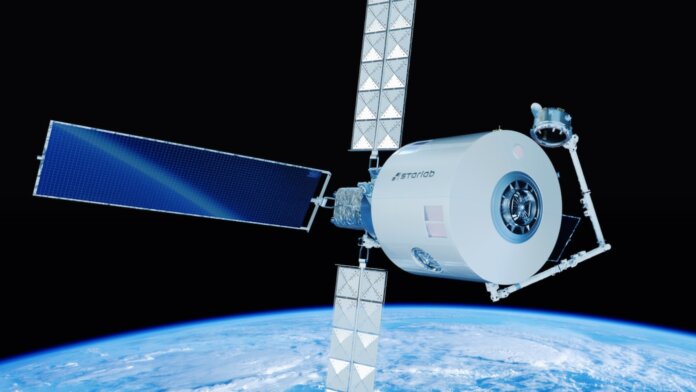SpaceX’s forthcoming Starship rocket will make it possible to lift unprecedented amounts of material into orbit. One of its first customers will be a commercial space station, which will be launched fully assembled in a single mission.
Measuring 400 feet tall and capable of lifting 150 tons to low-Earth orbit, Starship will be the largest and most powerful rocket ever built. But with its first two test launches ending in “rapid unscheduled disassembly”—SpaceX’s euphemism for an explosion—the spacecraft is still a long way from commercial readiness.
That hasn’t stopped customers from signing up for launches. Now, a joint venture between Airbus and Voyager Space that’s building a private space station called Starlab has inked a contract with SpaceX to get it into orbit. The venture plans to put the impressive capabilities of the new rocket to full use by launching the entire 26-foot-diameter space station in one go.
“Starlab’s single-launch solution continues to demonstrate not only what is possible, but how the future of commercial space is happening now,” SpaceX’s Tom Ochinero said in a statement. “The SpaceX team is excited for Starship to launch Starlab to support humanity’s continued presence in low-Earth orbit on our way to making life multiplanetary.”
Starlab is one of several private space stations currently under development as NASA looks to find a replacement for the International Space Station, which is due to be retired in 2030. In 2021, the agency awarded $415 million in funding for new orbital facilities to Voyager Space, Northrop Grumman, and Jeff Bezos’ company Blue Origin. Axiom Space also has a contract with NASA to build a commercial module that will be attached to the ISS in 2026 and then be expanded to become an independent space station around the time its host is decommissioned.
Northrop Grumman and Voyager have since joined forces and brought Airbus on board to develop Starlab together. The space station will only have two modules—a service module that provides energy from solar panels as well as propulsion and a module with quarters for a crew of four and a laboratory. That compares to the 16 modules that make up the ISS. But at roughly twice the diameter of its predecessor, those two modules will still provide half the total volume of the ISS.
The station is designed to provide an orbital base for space agencies like NASA but also private customers and other researchers. The fact that Hilton is helping design the crew quarters suggests they will be catering to space tourists too.
Typically, space stations are launched in parts and assembled in space, but Starlab will instead be fully assembled on the ground. This not only means it will be habitable almost immediately after launch, but it also greatly simplifies the manufacturing process, Voyager CEO Dylan Taylor told Tech Crunch recently.
“Let’s say you have a station that requires multiple launches, and then you’re taking the hardware and you’re assembling it [on orbit],” he said. “Not only is that very costly, but there’s a lot of execution risk around that as well. That’s what we were trying to avoid and we’re convinced that that’s the best way to go.”
As Starship is the only rocket big enough to carry such a large payload in one go, it’s not surprising Voyager has chosen SpaceX, even though the vehicle they’re supposed to fly is still under development. The companies didn’t give a timeline for the launch.
If they pull it off, it would be a major feat of space engineering. But it’s still unclear how economically viable this new generation of private space stations will be. Ars Technica points out that it cost NASA more than $100 billion to build the ISS and another $3 billion a year to operate it.
The whole point of NASA encouraging the development of private space stations is so it can slash that bill, so it’s unlikely to be offering anywhere near that much cash. The commercial applications for space stations are fuzzy at best, so whether space tourists and researchers will provide enough money to make up the difference remains to be seen.
But spaceflight is much cheaper these days thanks to SpaceX driving down launch costs, and the ability to launch pre-assembled space stations could further slash the overall bill. So, Starlab may well prove the doubters wrong and usher in a new era of commercial space flight.
Image Credit: Voyager Space



